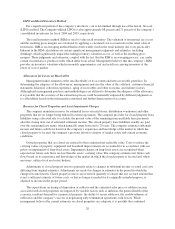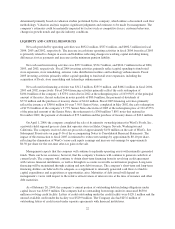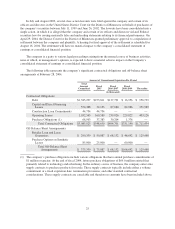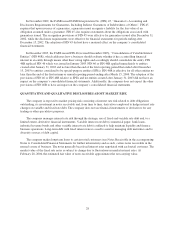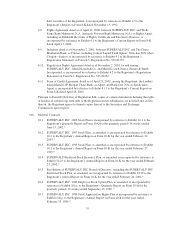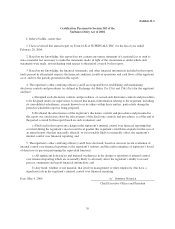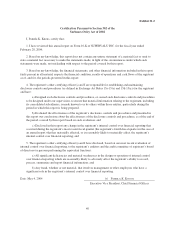Albertsons 2004 Annual Report Download - page 35
Download and view the complete annual report
Please find page 35 of the 2004 Albertsons annual report below. You can navigate through the pages in the report by either clicking on the pages listed below, or by using the keyword search tool below to find specific information within the annual report.commodity prices, (iv) the availability of favorable credit and trade terms, and (v) other economic
conditions that may affect consumer buying habits. Any one or more of these economic conditions can
affect our retail sales, the demand for products we distribute to our retailer customers, our operating
costs and other aspects of our businesses.
‰Competition. The industries in which we compete are extremely competitive. Both our retail food and
food distribution businesses are subject to competitive practices that may affect: (i) the prices at which
we are able to sell products at our retail locations, (ii) sales volume, (iii) the ability of our distribution
customers to sell products we supply, which may affect future orders, and (iv) our ability to attract and
retain customers. In addition, the nature and extent of consolidation in the retail food and food
distribution industries could affect our competitive position or that of our distribution customers in the
markets we serve.
Our retail food business faces competition from other retail chains, supercenters, non-traditional
competitors and emerging alterative formats in the markets where we have retail operations. In our
food distributions business, our success depends in part on the ability of our independent retailer
customers to compete with these same formats, our ability to attract new customers, and our ability to
supply products in a cost effective manner. Declines in the level of retail sales activity of our
distribution customers due to competition; consolidations of retailers or competitors; increased self-
distribution by our customers; or the entry of new or non-traditional distribution systems into the
industry may adversely affect our revenues.
‰Labor Relations and Employee Benefit Costs. Potential work disruptions from labor disputes may
affect sales at our stores as well as our ability to distribute products. We contribute to various multi-
employer healthcare and pension plans covering certain union represented employees in both our retail
and distribution operations. Approximately one-third of the employees in our total workforce are
participants in multi-employer plans. The costs of providing benefits through such plans have escalated
rapidly in recent years. Based upon information available to us, we believe certain of these multi-
employer plans are underfunded. The decline in the value of assets supporting these plans, in addition
to the high level of benefits generally provided, has led to the underfunding. As a result, contributions
to these plans will continue to increase and the benefit levels and related issues will continue to create
collective bargaining challenges.
‰Expansion and Acquisitions. While we intend to continue to expand our retail and distribution
businesses through new store openings, new affiliations and acquisitions, expansion is subject to a
number of risks, including the adequacy of our capital resources, the location of suitable store or
distribution center sites and the negotiation of acceptable purchase or lease terms; and the ability to hire
and train employees. Acquisitions may involve a number of special risks, including: making
acquisitions at acceptable rates of return, the diversion of management’s attention to the assimilation of
the operations and integration of personnel of the acquired business, costs and other risks associated
with integrating or adapting operating systems, and potential adverse effects on our operating results.
‰Liquidity. We expect to continue to replenish operating assets with internally generated funds.
However, if our capital spending significantly exceeds anticipated capital needs, additional funding
could be required from other sources including borrowing under our bank credit lines or through debt
issuances. In addition, acquisitions could affect our borrowing costs and future financial flexibility.
‰Domestic Security. Wartime activities, threats, and acts of terror directed at the food industry as well
as related security costs can affect consumer behavior and spending as well as customer orders.
ITEM 7A. QUANTITATIVE AND QUALITATIVE DISCLOSURES ABOUT MARKET RISK
The information called for by Item 7A is found under the heading of “Quantitative and Qualitative
Disclosure About Market Risk” under Part II, Item 7 above.
30


